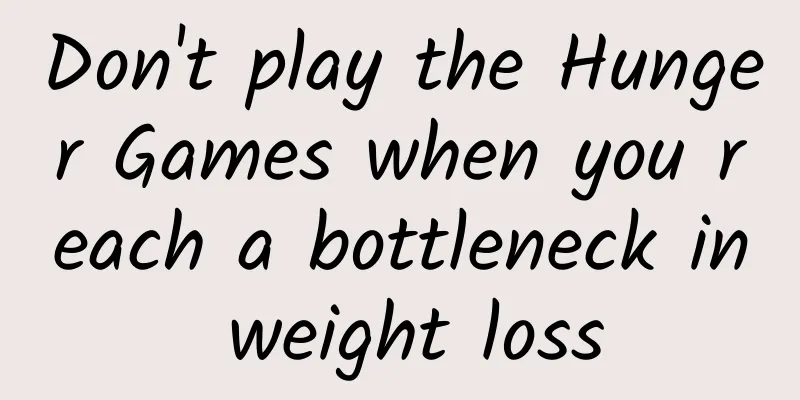Don't play the Hunger Games when you reach a bottleneck in weight loss

|
[Key points]: The happiest time for weight loss is when you start losing weight quickly. The most painful time is when you encounter a bottleneck. Here are 4 ways to help you solve the big problem of encountering a bottleneck in weight loss. When we first start losing weight, we all take a lot of measures. For example, restricting carbohydrate intake, not drinking fruit juice, not eating fried foods, and rapidly increasing the amount of exercise, etc. Therefore, in the early stages of weight loss, weight loss tends to be more obvious. Generally speaking, about one month after starting to lose weight, if you follow the principles of diet and exercise, your weight will generally drop by about 5%. But at this time, the body's balance mechanism has begun to work. The body's balance mechanism, like the body's crisis management system, will take countermeasures to maintain the body's nutrient absorption rate. At this time, weight loss has reached a bottleneck period. We have entered a bottleneck period, but of course, we should not be discouraged. Anxiously thinking that one's efforts are not rewarded. What should I do if I reach a bottleneck in weight loss? Here are 4 good ways: Point 1: Don’t play the “Hunger Games” I believe that many people will take actions such as increasing the amount of exercise and controlling the number of calories more strictly when they are in a bottleneck period. While consistent exercise is important, starvation mode can have the opposite effect! When losing weight, in order to meet human nutritional needs, the daily diet intake is about 1200 to 1500 calories. However, in order to break through the weight loss plateau, what you need to do is not to reduce your calorie intake, but to increase your calorie intake. To this end, you can eat 500 calories more per day. (Avoid junk food and fast food!) Wait until you are through the plateau period before returning to normal calories for weight loss. Point 2: Take a holiday to lose weight "Trying too hard may backfire," this sentence also applies to the bottleneck period of weight loss. Therefore, during the bottleneck period, you should also give your weight loss a break. Simply put, don't be too eager for quick success and make yourself too tired. Listen to your body and rest and relax when you are tired. For example, get more sleep time, put aside body training for the time being, etc. You need a day off 1 to 2 days a week to lose weight! Point 3: Talk to professionals When you reach a bottleneck in weight loss, you may want to seek advice from professionals. This person can be a close friend who has successfully lost weight, or a personal trainer at your own gym. Ask them to re-evaluate their training and dining content during this period, and then give a new suggestion. Point 4: Diet can be adjusted like this ★Fresh Vegetables and Crispy Beans Promote gastric motility, solve intestinal problems, improve digestion ability and reduce the accumulation of excess waste in the body. Ingredients (for 2 people): half a cabbage, 60 grams of chickpeas, half a white onion, some celery, a small amount of salt, 1 teaspoon of lemon juice, 1 tablespoon of olive oil, a small amount of black pepper. practice: 1. Cut the cabbage into pieces at random, remove the leaves of celery and cut into sections, wash the onion, peel it, cut it into thin strips and put it in water for later use. 2. Put 5 cups of water in a pot, add salt and olive oil, bring to a boil, then add the cabbage and cook over low heat for 4-5 minutes. 3. Then remove the cabbage, add the chickpeas and cook over medium heat for 4-5 minutes. 4. Put salt, lemon juice, olive oil and black pepper in a bowl to make the sauce, then mix the cabbage, chickpeas, celery and white onion. ★Colorful fresh vegetables Fresh vegetables alone can produce the same amount of calcium as a cup of milk. The method is simple and convenient, and the sour and spicy taste is also very good! Ingredients (2 servings): 1 handful of hijiki, 1/4 white onion and purple onion, 2 lentils, appropriate amount of red and yellow bell peppers, 1 teaspoon of minced garlic, half a lemon, 1 and a half teaspoons of olive oil, 1/3 cup of water, 2 tablespoons of soy sauce, 1 chili pepper, and appropriate amount of salt. practice: 1. Soak the hijiki in water for 20-30 minutes. Cut the onion into thin rings and put them in the water for later use. 2. Blanch the lentils in water for a while, then remove them and cut them into strips. Remove the bell pepper sac and cut it into shreds. Chop the chili pepper into small pieces. 3. Heat the pan with olive oil, sauté the minced garlic over low heat, then add the chili and hijiki, then add water and soy sauce and cook over medium heat. 4. Stir-fry until the water evaporates, add lemon juice and salt to taste, and mix with other vegetables. Source: 39 Health Network www.39.net Please do not reprint without written authorization |
<<: Come be a scheming woman! 4 eating habits that make eating easy without gaining weight
>>: Don’t gain weight during the Chinese New Year! 7 Tips for Smart Eating
Recommend
Painless abortion patients need to pay attention to these aspects before surgery
Painless abortion is a more recommended method of...
Can VC be used to treat vaginal candidal infection?
Fungal vaginitis is caused by infection with Cand...
What are the methods to prevent threatened miscarriage?
There are many ways to prevent threatened abortio...
How to check pathogens in chronic cervicitis
The pathogen detection of chronic cervicitis is m...
How can you eat during your menstrual period without getting fat? Debunking 3 weight loss myths
I don't know where I heard this saying: "...
What are the symptoms of ovarian cysts? Does it have a big impact on pregnancy?
What are the symptoms of ovarian cysts? Does it h...
Do you know the harm of dysmenorrhea to women?
I believe that all of my friends have experienced...
How to prevent female cervical erosion from spreading?
Female cervical erosion is a common disease in gy...
The secret of menstrual cycle weight loss method revealed! Traditional Chinese Medicine: Drinking chicken soup increases metabolism, making weight loss easier
Many women often think that the menstrual period ...
What are the symptoms of cervical erosion in women? Four common symptoms of cervical erosion in women
Cervical erosion often occurs in adult women. The...
Too much visceral fat will lead to cardiovascular disease! Nutritionist Shi Shanling: Get rid of visceral fat from three meals
After eating and drinking a lot, I suddenly reali...
What are the specific dangers of Bartholinitis?
Nowadays, many women who suffer from gynecologica...
Can women with uterine fibroids eat glutinous rice? Women with uterine fibroids should pay attention to two major issues
Patients with uterine fibroids must cooperate wit...
Learn about seven common causes of adnexitis
Nowadays, female friends are paying more and more...
Daily habits to help you prevent irregular menstruation
Irregular menstruation is often a sign of endocri...









